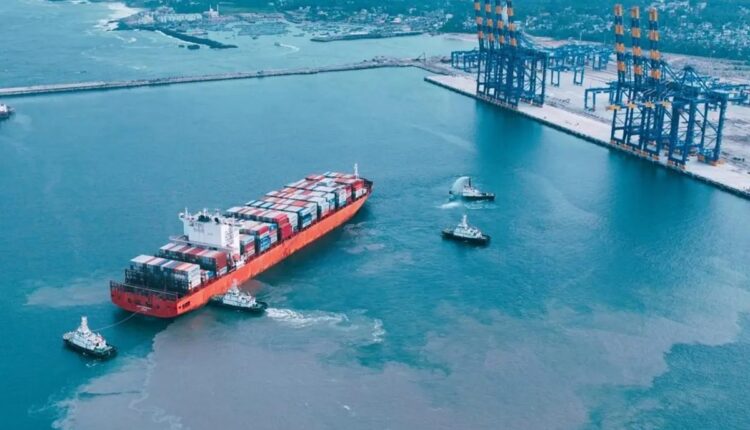Sea News – International Desk – The inauguration of Vizhinjam deep-sea port in India’s Kerala state marks a turning point in the country’s maritime strategy. Developed with an initial investment of $1.04 billion through a public-private partnership between the Adani Group and the Kerala state government, this multipurpose port can accommodate ultra-large container vessels such as the MSC Turkiye (with a capacity of over 24,000 TEUs). By 2028, the port is expected to reach a capacity of 5 million TEUs with a total investment of $2.11 billion. Located just 10 nautical miles from major international shipping lanes, Vizhinjam could internalize up to 75% of India’s transshipment cargo that is currently handled by ports like Colombo, Singapore, and Jebel Ali. This transformation is expected to generate substantial foreign exchange savings and create new economic opportunities for India.
However, the rise of Vizhinjam raises questions about the strategic position of Iran’s Chabahar Port—our country’s only deep-sea port. Strategically located near key international routes and serving as a crucial node in the North-South Transport Corridor, Chabahar has long been positioned as Iran’s transit gateway to Central Asia, India, and Europe. The key question now is: will Vizhinjam emerge as a competitor to Chabahar, or can the two serve as strategic allies in a regional logistics chain?
Vizhinjam: Opportunities and Challenges
With a natural depth of 20 meters, Vizhinjam is capable of receiving the world’s largest container ships. It can reduce shipping times by up to two weeks and cut container handling costs by $600 to $1,000, resulting in billions of rupees in annual savings for India. Yet, the project has faced strong opposition from local fishermen and environmental activists. The documentary “Stolen Shores” reveals that the port has directly impacted around 450 fishing families and indirectly affected approximately 4,500 due to coastal erosion and wave pattern disruptions. These issues raise concerns about the project’s sustainability and social acceptance.
Chabahar: Iran’s Transit Gateway
Chabahar Port, developed with an initial $500 million investment from India, forms a central part of the shared regional connectivity strategy between Iran and India. With direct access to the Indian Ocean and overland links to Central Asia, Afghanistan, and Europe via the North-South Corridor, Chabahar holds the potential to become a key transit hub. Unlike Vizhinjam, Chabahar has yet to reach full operational capacity, but its location—independent of the Strait of Hormuz—is a major strategic advantage. By accelerating development of its subsequent phases and offering competitive incentives, Iran can attract a significant share of regional transshipment cargo.
Competition or Cooperation?
While the launch of Vizhinjam may intensify short-term competition with Chabahar—especially given India’s massive investments and the port’s proximity to Asian markets—a long-term view suggests complementarity. Chabahar, with its northbound connectivity to Central Asia and Europe, could serve as a gateway for Vizhinjam’s transshipment cargo to inland markets. The existing bilateral agreements between Iran and India on Chabahar lay a solid foundation for such strategic cooperation. For instance, cargo arriving at Vizhinjam could be redirected via Chabahar to Afghanistan, Uzbekistan, or even Russia, reducing both transport costs and transit times.
Iran can also learn from Vizhinjam’s environmental and social challenges. By emphasizing sustainable development at Chabahar—protecting coastal ecosystems and involving local communities—Iran can strengthen its competitive advantage. Active regional diplomacy, especially in coordination with India, China, and Central Asian countries, can help position Chabahar as a complementary hub to Vizhinjam. Such cooperation would reduce regional reliance on ports like Colombo and Jebel Ali, while establishing Iran as a key transit node in East-West and North-South trade corridors.
Recommendations for Strengthening Chabahar’s Position
To leverage the opportunity created by the opening of India’s Vizhinjam Port and to transform Chabahar into a regional transit hub, Iran must undertake targeted strategic actions. First, infrastructure development at Chabahar must accelerate. This could be achieved through attracting foreign investment—especially from countries like India and China that have previously expressed interest. India’s $500 million investment in Chabahar’s first phase could serve as a model for deeper cooperation in future phases. Second, financial and logistical incentives for transshipment carriers and companies are essential. Measures such as port fee discounts and streamlined customs procedures could make Chabahar a more attractive destination. Third, Iran should avoid the environmental and social pitfalls faced by Vizhinjam by prioritizing sustainable growth—protecting coastal ecosystems, engaging local communities, and preventing shoreline erosion. Lastly, enhancing diplomatic negotiations with India to formally include Chabahar in a shared regional logistics network alongside Vizhinjam is crucial. This could pave the way for an integrated supply chain where cargo flows from Vizhinjam to Chabahar and onwards to Central Asia and Europe—solidifying Iran’s role as a regional logistics powerhouse.
Though Vizhinjam and Chabahar may initially appear as regional rivals, they possess significant potential to evolve into strategic partners. A collaborative approach between the two ports could strengthen the regional logistics chain and reduce dependency on non-regional hubs. By leveraging Chabahar’s geostrategic location and advancing proactive economic diplomacy, Iran can turn Vizhinjam’s emergence into a strategic opportunity—and assert itself as a vital transit hub linking Asia to Europe and beyond.
Inspired by: Arab News

